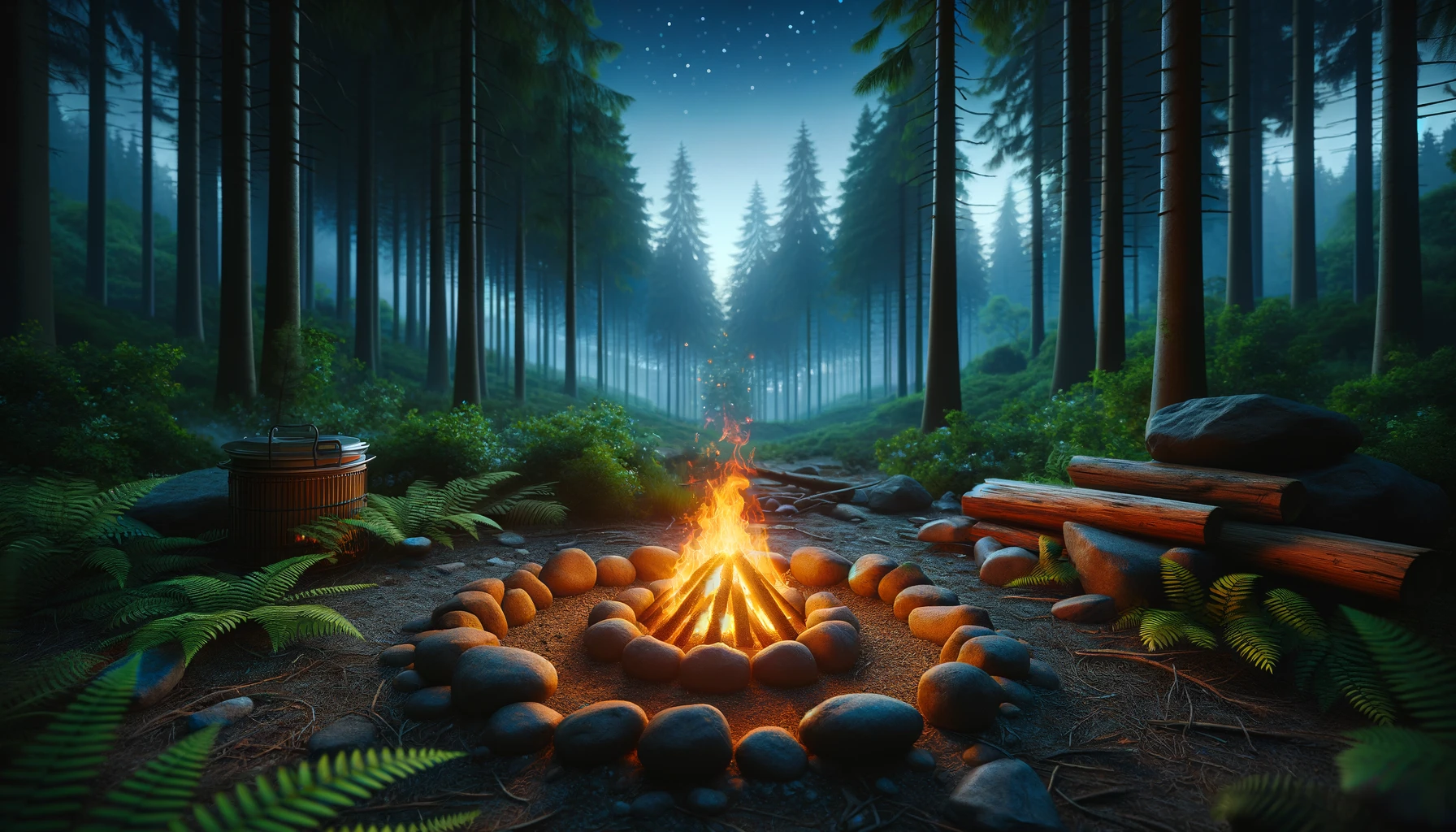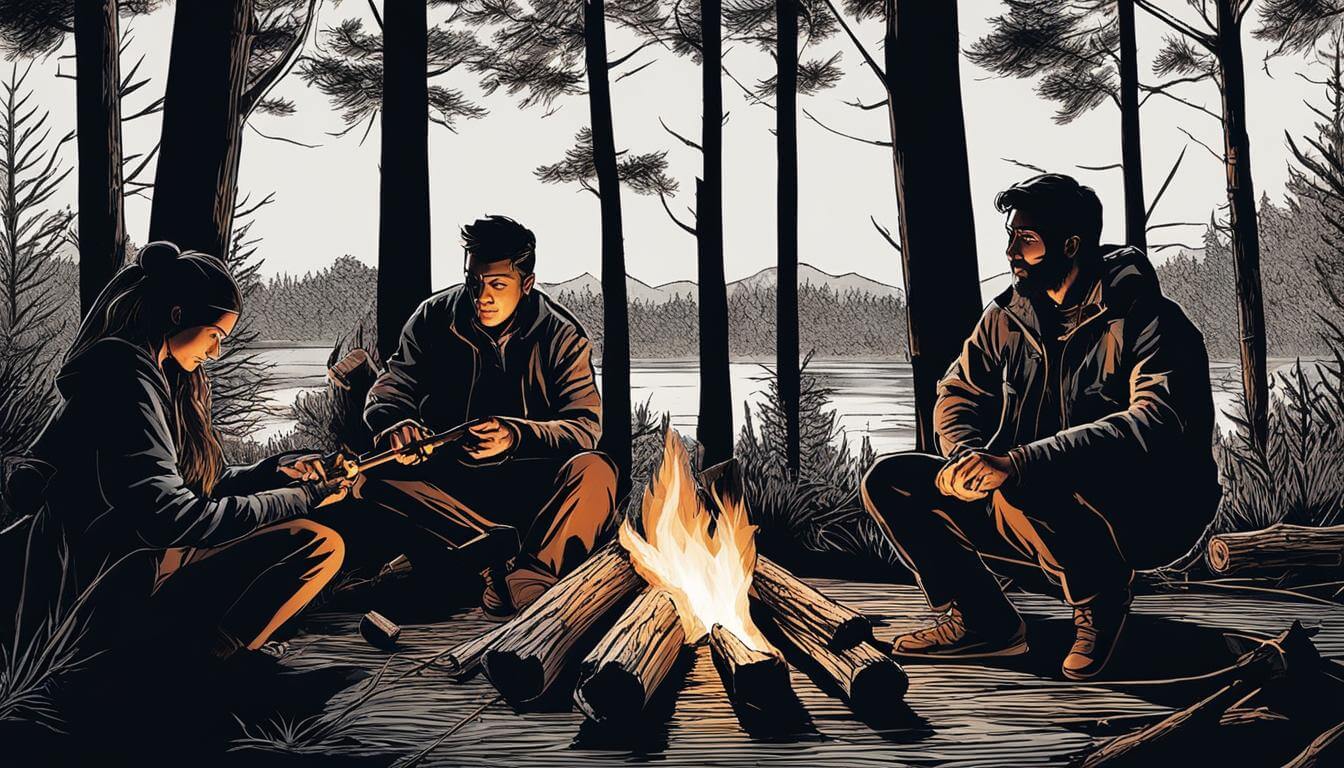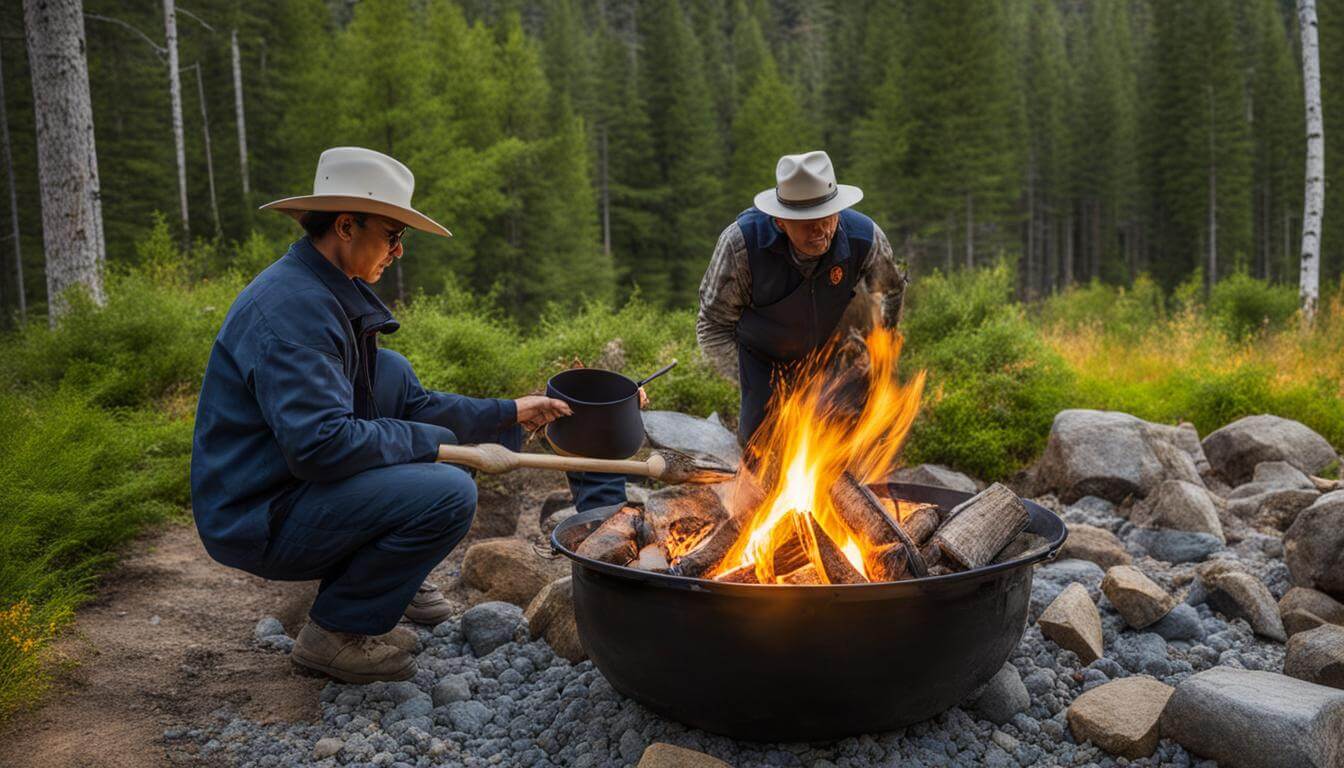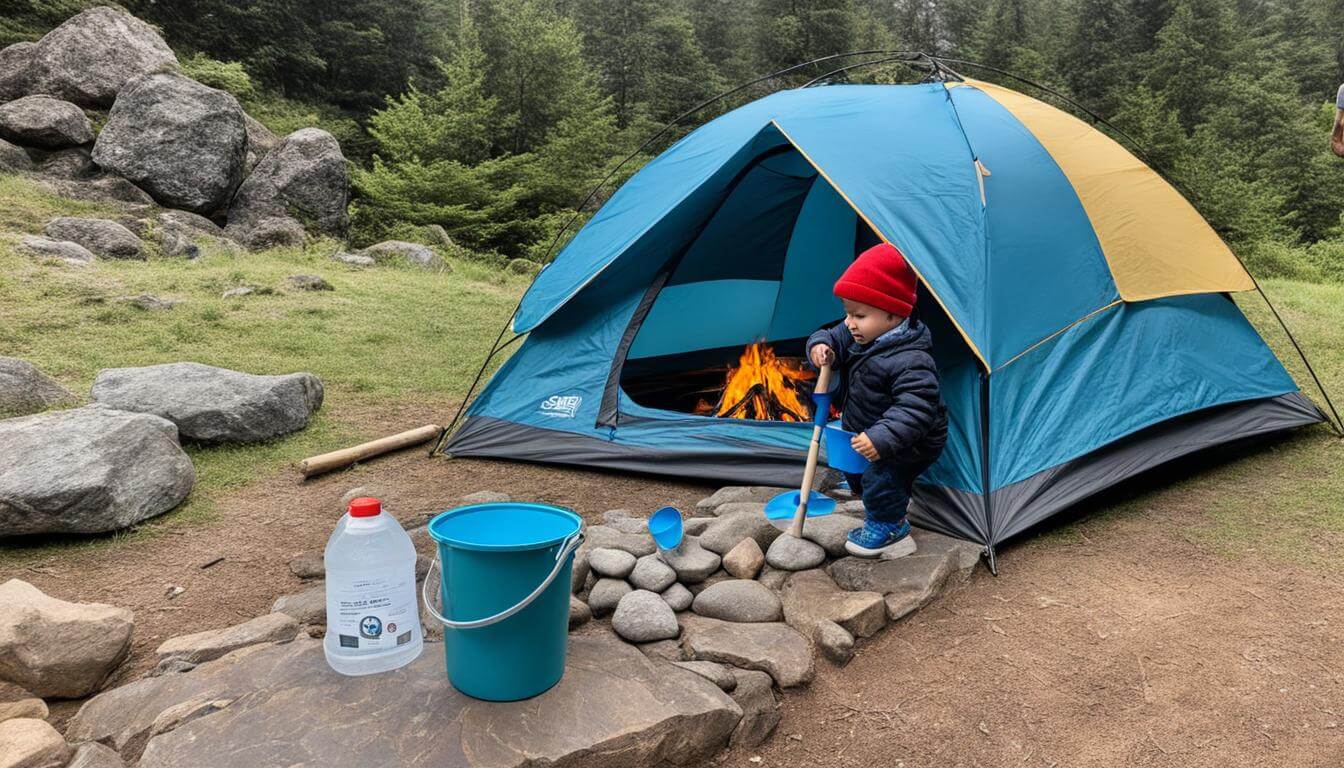Campfire Building and Safety for Beginners

Hello, I'm excited to share with you my insights on campfire building and safety. Whether you're a seasoned camper or just starting, understanding the essentials of campfire safety is crucial for a successful outdoor experience. In this beginner's guide, I will provide valuable tips and guidelines on how to build a safe campfire, ensuring that you can enjoy the warmth and ambience while prioritizing the well-being of yourself and others.

Before we dive into the details, let's take a moment to understand the importance of campfire safety. Campfires can be a source of joy and relaxation. Still, they can pose serious risks, such as wildfires and injuries, if not handled responsibly. By following campfire safety precautions and guidelines, you can minimize these risks and create a safe environment for everyone to enjoy.
Key Takeaways:
- Learn essential campfire safety tips for a secure outdoor experience.
- Understand the proper techniques and guidelines for building a safe campfire.
- Familiarize yourself with campfire safety rules and essentials.
- Implement fire safety practices to prevent accidents and ensure responsible campfire enjoyment.
- Teach fire safety to children to instil responsible behaviour around campfires.
Understanding the Basics of Campfire Safety
Before embarking on any campfire adventure, it is crucial to understand the basics of campfire safety. By following essential practices and guidelines, you can ensure a safe and enjoyable campfire experience. From choosing a safe location to managing wind and elements, these basics will prepare you to handle a campfire responsibly.
One of the first steps in campfire safety is selecting a safe location. Look for a spot away from flammable materials and low-hanging branches. Consider wind conditions and choose a sheltered area if possible. By taking these precautions, you can minimize the risk of the fire spreading uncontrollably and causing accidents.
Once you have found a suitable location, gathering the necessary materials for your campfire is essential. This includes tinder, kindling, and fuelwood. Ensure that the materials are dry and easily combustible to facilitate the ignition process.
Next, it is essential to construct a safe fire ring to contain the fire and prevent it from spreading. A fire ring can be made by arranging large rocks or using a portable fire pit. This helps maintain a controlled fire and reduces the risk of accidents.
When it comes to igniting the fire, it is crucial to follow safety guidelines. Use matches or a lighter to ignite the fuel and gradually add larger pieces of kindling. Remember to keep a safe distance from the fire and avoid wearing loose-fitting clothing that could catch fire.
Throughout the campfire, managing wind and external elements is important. Strong winds can lead to an uncontrolled fire, so position yourself and your campfire to minimize the impact of wind. Additionally, be cautious of debris or objects that could blow into the fire and cause accidents.
To summarize, understanding the basics of campfire safety is vital for a safe and enjoyable experience. By following these guidelines, such as choosing a secure location, gathering the suitable materials, constructing a fire ring, and managing wind and elements, you can significantly reduce the risk of accidents and ensure a worry-free campfire adventure.
Prepping Your Campfire Site with Care
Prepping your campfire site is crucial for ensuring the safety and success of your outdoor experience. Careful consideration must be given to two critical aspects of site preparation: selecting the right location and clearing debris. By taking these necessary precautions, you can create a controlled and secure environment for your campfire.
Selecting the Right Location
When choosing a location for your campfire, several factors should be considered: Be aware of any fire bans or restrictions in the area. Ensure you are allowed to have a campfire and comply with any regulations. Consider the wind conditions and choose a site protected from strong gusts. This will prevent sparks from spreading and create a more enjoyable experience without excessive smoke. Assessing the proximity of flammable materials such as trees, bushes, and overhanging branches is crucial. Selecting a location away from these hazards will minimize the risk of fires spreading uncontrollably.
Clearing Debris and Setting Boundaries
Before starting your campfire, it is essential to clear the area of any debris that could pose a potential fire hazard. Remove dry leaves, twigs, and other combustible materials from the vicinity. This includes creating a suitable space around the fire ring to prevent accidental ignition of nearby materials. Setting clear boundaries will help contain the fire and ensure it remains within the designated area. This can be accomplished by creating a physical barrier using stones, logs, or other non-flammable materials. By clearing debris and setting boundaries, you can significantly reduce the risk of accidental fires and promote a safer campfire environment.
The Essentials for a Safe Campfire Setup
Building a safe campfire requires having the necessary materials and setting up a proper fire ring. This section guides gathering your materials and constructing a safe fire ring to ensure a secure and enjoyable campfire experience.
Gathering Your Materials
When it comes to a successful campfire setup, having suitable materials is essential. Here are the key items you'll need:
- Tinder: Start with small, highly flammable materials such as dry leaves, grass, or newspaper. These will help ignite the fire quickly.
- Kindling: Gather small sticks and twigs to build the initial flames and generate enough heat to ignite the larger pieces of firewood.
- Fuelwood: Select larger logs or branches that sustain the fire once it's burning strongly.
Remember to collect firewood from the designated area and use fallen or dead wood. Avoid cutting or damaging live trees.
Constructing a Safe Fire Ring
Creating a fire ring is critical to prevent the firing from spreading. Follow these steps to construct a safe fire ring:
- Clear the area around the fire ring to remove any flammable materials or vegetation.
- Choose a spot with a non-combustible surface, such as sand or gravel, and ensure it is at least 15 feet away from tents, trees, and other structures.
- Arrange rocks or stones in a circle to form the fire ring. Make sure the ring is sturdy and wide enough to contain the fire.
- Leave an opening in the fire ring to allow for airflow and to add firewood.
By gathering the suitable materials and constructing a safe fire ring, you can establish a secure campfire setup that minimizes the risk of accidents and promotes responsible campfire enjoyment.
Choosing Your Campfire Building Technique
When it comes to building a campfire, there are different techniques you can use to create the perfect flame. The choice of technique depends on your specific needs and preferences. In this section, I'll explore popular campfire building methods: teepee, lean-to, cross, and log cabin. Each technique has advantages and can be suitable for different purposes, such as cooking, warmth, or creating a visually appealing fire.
Teepee Technique:
The teepee technique involves arranging the kindling and fuelwood in a cone-shaped structure resembling a teepee. This method allows for efficient airflow and creates a strong flame that burns from the top down, making it ideal for cooking and providing warmth.
Lean-To Technique:
The lean-to technique is simple but effective. Start by diagonally positioning a log or branch against a standing support, like a tree or rock. Then, stack the kindling against the lean-to structure, allowing the fire to burn upward. This method is proper when you have limited firewood and need a quick and easy fire.
Cross Technique:
The cross technique involves stacking the firewood in a crisscross pattern, forming a sturdy and self-supporting structure. This method allows for a longer-lasting fire and is suitable for situations where you want the fire to burn slowly, providing warmth throughout the night.
Log Cabin Technique:
The log cabin technique is a visually appealing method that involves stacking the firewood in a square or rectangular shape, alternating the orientation of each layer. This technique creates a well-ventilated fire, making it great for cooking and enjoying a cosy campfire ambience.
To visually understand these techniques, take a look at the image below:
By understanding and practising these different campfire building techniques, you can choose the most suitable method based on your specific needs and create a campfire that provides warmth, cooking capabilities, or an inviting ambience. Remember always to prioritize safety and follow the guidelines provided in earlier sections to ensure a safe and enjoyable campfire experience.
Igniting the Fire: Do it the Safe Way
When it comes to igniting a campfire, safety should always be the top priority. You can ensure a controlled and safe fire by following the necessary precautions and considering external factors such as wind and elements. It is essential to match up with safety guidelines, preventing accidents and promoting responsible campfire enjoyment. Here are some tips to help you manage wind and elements during a campfire, ensuring a safe and enjoyable experience.
Matching Up with Safety
Before igniting your campfire, make sure to review and follow the recommended fire safety precautions. This includes using proper fire-starting tools and materials, such as matches or lighters designed for outdoor use. Avoid flammable liquids or accelerants, leading to uncontrolled fires and accidents. Additionally, always have a fire extinguisher or water source nearby to extinguish the flames if needed quickly.
Remember, campfires should always be supervised. Ensure there is always someone responsible for monitoring the fire and that children and pets are kept at a safe distance. Taking these precautions will help prevent accidents and ensure a safer campfire experience for everyone involved.
Managing Wind and Elements
One of the biggest challenges regarding campfires is managing wind and other elements that can affect the fire's behaviour. Strong winds can quickly spread embers and flames, increasing the risk of accidents and causing wildfires. To manage wind during a campfire, consider these tips:
- Position your campfire in a sheltered, wind-resistant area near a natural windbreak like trees or rocks.
- Use a fire ring or fire pit, or create a barrier around the campfire to contain the flames, minimizing the chances of stray embers being carried by the wind.
- Keep combustible materials like dry leaves, grass, and branches away from the fire to avoid ignition and potential windblown fires.
- Monitor the wind direction and adjust the positioning of your seating area and tents accordingly to avoid smoke inhalation and ensure everyone's safety.
By managing wind and elements effectively, you can minimize the risk of accidents and maintain a safer campfire environment.
Keeping Your Campfire Under Control
Once the campfire is lit, it's essential to maintain control to prevent accidents and ensure a safe environment. By implementing certain campfire safety measures, you can minimize the risk of incidents and enjoy your campfire responsibly.
Here are some key safety measures to consider:
- Keep the fire small: Maintain a manageable fire size to prevent it from getting out of control. This will help minimize the risk of accidents and ensure better control over the fire.
- Add tinder and kindling appropriately: Gradually add additional tinder and kindling to maintain a consistent flame. This prevents sudden flare-ups and keeps the fire at a controlled level.
- Maintain a close eye on the fire: Continuously supervise the campfire throughout its duration. Regularly check for sparks or embers that may escape the fire ring and ensure the fire remains contained.
Remember, campfire safety is paramount. It's essential to exercise caution and follow these measures to prevent campfire accidents and ensure the safety of everyone around the fire.
By implementing these safety measures, you can maintain a safe campfire and minimize the risk of incidents. Responsible campfire enjoyment starts with keeping the fire under control and prioritizing the safety of yourself and others.

Campfire Building and Safety
This section serves as a comprehensive overview of campfire building and safety, summarizing the key points from the previous sections. It provides a holistic understanding of campfire safety practices, from site preparation to fire control. By referring to this all-inclusive guide, beginners and outdoor enthusiasts can gain the knowledge and confidence to build and enjoy a campfire safely.
" Building a campfire is an art that requires both skill and responsibility. By following the campfire building tips and safety guidelines discussed in this guide, you can create a warm and inviting campfire while ensuring the safety of yourself, others, and the environment."
" Remember, campfire safety is not just about protecting yourself and your surroundings; it's also about being respectful of nature and preserving the beauty of our outdoor spaces for future generations."
| Campfire Building Tips | Campfire Safety Guidelines |
|---|---|
|
|
Teaching Fire Safety to the Younger Ones
Teaching fire safety to children is of utmost importance to ensure their well-being and promote responsible campfire enjoyment. By starting with basic rules and gradually providing hands-on experience, we can help children develop essential fire safety skills. Parents and educators play a vital role in guiding children through practical lessons and encouraging responsible behaviour around campfires. Instilling these lessons early on lays a strong foundation for children to grow up with a deep understanding of fire safety.
Starting with Basic Rules
When teaching fire safety to children, it is crucial to begin with basic rules that establish a solid understanding of fire hazards and safety precautions. Here are some key points to cover:
- Never play with fire or matches: Explain to children the dangers of playing with fire and the importance of treating matches and lighters as tools used by adults only.
- Stay away from open flames: Teach children to keep a safe distance from campfires, candles, or any other open flames to avoid burns or accidents.
- Stop, drop, and roll: Educate children on the " stop, drop, and roll" technique in case their clothes catch fire, emphasizing the importance of staying calm and knowing how to extinguish flames on their bodies.
- Report emergencies: Teach children to immediately inform an adult or call emergency services in case of a fire or any fire-related emergencies.
Guidance Through Hands-On Experience
Hands-on experience is crucial for children to develop practical fire safety skills and reinforce the lessons taught. Engaging children in supervised activities related to fire safety can enhance their understanding and confidence. Here are some activities to consider:
- Fire drills: Conduct regular fire drills in different scenarios, such as an outdoor campfire or a simulated indoor fire, to teach children how to respond quickly and calmly in emergencies.
- Fire extinguisher training: Teach older children how to use a fire extinguisher safely, emphasizing the importance of reading instructions and aiming at the base of the fire.
- Campfire cooking: Involve children in preparing meals over a campfire, teaching them how to handle food safely and keep a safe distance from the flames.
- Fire escape plan: Collaborate with children to create a fire escape plan for their home or camping site, highlighting the importance of having multiple escape routes and a designated meeting point.
Through hands-on experience and practical lessons, children can develop important fire safety skills that will stay with them throughout their lives. Encouraging responsible behaviour and respect for fire can help them enjoy campfires safely while ensuring the well-being of themselves and others.

Preparing for the Unexpected
Despite taking all necessary precautions, campfire accidents and emergencies can still occur. Preparing for the unexpected and knowing how to deal with campfire accidents is essential. Additionally, learning first aid for campfire incidents can make a significant difference in ensuring the safety of everyone involved.
In a campfire emergency, remaining calm and taking immediate action is crucial. Here are some campfire safety precautions and steps to follow:
- Assess the situation: Evaluate the severity of the accident or emergency. Determine whether it requires professional medical attention or can be handled on-site.
- Call for help: If necessary, contact emergency services or seek assistance from nearby campsites or park rangers.
- Isolate the area: Ensure the safety of others by cordoning off the affected area and preventing further harm.
- Administer first aid: If you have the knowledge and resources, provide immediate first aid to the injured person(s). This may involve performing CPR, applying bandages, or stabilizing fractures.
- Stay with the injured person(s): Keep a close eye on the injured person(s) until professional medical help arrives or until they recover.
Remember, prevention is always the best approach. However, in unforeseen circumstances, knowing how to deal with campfire accidents and having first aid knowledge can make a significant difference in the outcome. By prioritizing campfire safety precautions and being prepared for emergencies, everyone you can ensure a safer and more enjoyable camp for everyone.
Conclusion
In conclusion, fire safety is paramount regarding campfire building and enjoyment. Throughout this article, I have highlighted the essential guidelines and practices to ensure a safe and responsible campfire experience. By prioritizing fire safety, we can minimize the risk of accidents and harm, creating a positive and enjoyable environment for all.
Reflecting on the key takeaways from this article, it is clear that selecting the right campfire location, prepping the campfire site with care, and gathering the necessary materials are crucial steps in building a safe campfire. Understanding different campfire building techniques, igniting the fire safely, and managing the fire are also essential. Additionally, educating children about fire safety and being prepared for any unexpected incidents are vital aspects of responsible campfire enjoyment.
By adopting a responsible approach and following these guidelines, we can protect ourselves, our loved ones, and the wilderness, ensuring that campfire experiences are memorable and worry-free. So, let's prioritize fire safety and be responsible stewards of the great outdoors, creating lasting memories while enjoying the warmth and beauty of a well-built campfire.
FAQ
What are the basics of campfire safety?
The basics of campfire safety involve understanding practices and guidelines for building and maintaining a campfire, including choosing a safe location, managing wind and elements, and practising responsible fire safety measures.
How do I prep my campfire site?
Prep your campfire site by selecting a safe location away from flammable materials and clearing debris that could pose a hazard. Ensure there are no fire bans in the area, and consider wind conditions when choosing a spot for your campfire.
What materials do I need for a safe campfire setup?
To build a safe campfire, gather tinder, kindling, and fuelwood. These materials will help you start and maintain a fire. Additionally, construct a fire ring to contain the fire and prevent it from spreading.
What campfire building techniques can I use?
There are various campfire building techniques, including teepee, lean-to, cross, and log cabin. Each method has advantages and may be suitable for different purposes, such as cooking or warmth.
How can I ignite a campfire safely?
Ignite a campfire safely by following precautions and considering external factors such as wind and elements. Match up with safety guidelines, and manage wind and elements to keep the fire under control and prevent potential hazards.
How can I keep my campfire under control?
Keep your campfire under control by maintaining a small fire, adding fuel and kindling appropriately, and always supervising the fire. These practices will help prevent accidents and ensure a safe campfire environment.
What does a comprehensive campfire building and safety guide cover?
A comprehensive campfire building and safety guide covers all aspects of campfire safety, including site preparation, fire setup, building techniques, ignition precautions, fire control, teaching fire safety to children, preparing for emergencies, and encouraging responsible campfire enjoyment.
How can I teach fire safety to children?
Start teaching children fire safety by explaining basic rules, such as not playing with fire and keeping a safe distance from the campfire. Gradually provide hands-on experience and guide them through practical lessons to develop essential fire safety skills. Parents and educators play a crucial role in fostering responsible behaviour around campfires.
How can I handle campfire accidents and emergencies?
Despite taking precautions, accidents and emergencies can still happen. Be prepared by knowing the necessary steps to take in case of injuries or incidents. Having first aid knowledge is also essential. Stay calm and act quickly to ensure everyone's safety.
